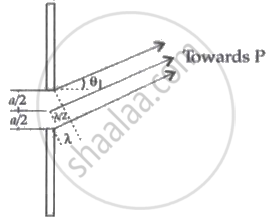Advertisements
Advertisements
प्रश्न
Derive the expression for the angular position of (i) bright and (ii) dark fringes produced in a single slit diffraction.
उत्तर
(i) Derivation of expression for the angular position of bright fringe produced by single slit diffraction:

The single slit is now divided into three equal parts.
If waves from two parts of the slit cancel each other, the wave from the third part will produce a maximum at a point between two minimums.
So, sin θ1 = `(3λ)/(2"a")`
Similarly, if the slit is divided into five equal parts, then another maximum will be produced at
sin θ2 = `(5λ)/(2"a")`
Similarly for other fringes, sin θn = `((2"n" + 1)λ)/(2"a")`
Or, θn = `((2"n" + 1)λ)/(2"a")`
For central maximum, θ = 0°
(ii) Derivation of expression for the angular position of dark fringe produced by single slit diffraction:

The single slit is divided into two equal halves. Every point in one half has a corresponding point in the other half. The path difference between two waves arriving at point P is
`"a"/(2sinθ_1) = λ/2`
This means the contributions are in opposite phases, so cancel each other and the intensity falls to zero.
So, for 1st dark fringe, sin θ1 = `(λ)/("a")`
Similarly for other dark fringes, sin θn = `("n"λ)/("a")`
θn = `("n"λ)/("a")`
संबंधित प्रश्न
Explain why the maxima at `theta=(n+1/2)lambda/a` become weaker and weaker with increasing n
Describe briefly how a diffraction pattern is obtained on a screen due to a single narrow slit illuminated by a monochromatic source of light. Hence obtain the conditions for the angular width of secondary maxima and secondary minima.
Monochromatic light of wavelength 4300 Å falls on a slit of width ‘a’. For what value of ‘a’ the first maximum falls at 30° ?
What should be the order of obstacle or aperture for diffraction of light?
The magnifying power of a telescope in normal adjustment is 24, when the length of the telescope tube 1 meter. The focal length of the eye lens is
Draw the graph showing intensity distribution of fringes with phase angle due to diffraction through a single slit. What is the width of the central maximum in comparison to that of a secondary maximum?
Write two points of difference between an interference pattern and a diffraction pattern.
How can you differentiate whether a pattern is produced by a single slit or double slit?
In a diffraction pattern due to a single slit, how will the angular width of the central maximum change, if orange light is used in place of green light?
Justify your answer.
In a diffraction pattern due to a single slit, how will the angular width of the central maximum change, if the screen is moved closer to the slit?
Justify your answer.
